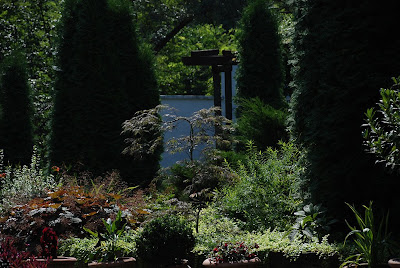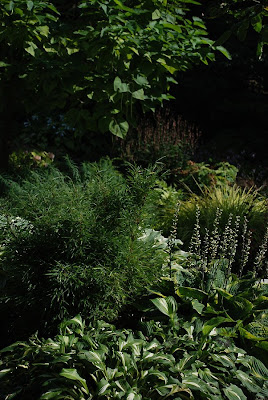Today we celebrate the Assumption of the Virgin Mary.
A short walk in the garden on this beautiful day, before the rain arrives.
 A quite young Acer palmatum 'Garnet'.
A quite young Acer palmatum 'Garnet'.
 Agastache rupestris, a licorice mint with an apricot colored flower. In contrast to other mints, it does not belong to Z7 but to Z5, thus it is certainly frost-resistant at us, too.
Agastache rupestris, a licorice mint with an apricot colored flower. In contrast to other mints, it does not belong to Z7 but to Z5, thus it is certainly frost-resistant at us, too.
 On the left side a brook thistle (Cirsium rivulare), in the middle a Gaura linderheimeri, while the grass in the background is a Pennisetum alopecuroides 'Hameln'.
On the left side a brook thistle (Cirsium rivulare), in the middle a Gaura linderheimeri, while the grass in the background is a Pennisetum alopecuroides 'Hameln'.
 Between the hostas there is a small bamboo that does not spread its rhizomes: Fargesia murieliae 'Bimbo'.
Between the hostas there is a small bamboo that does not spread its rhizomes: Fargesia murieliae 'Bimbo'.
 At the foot of the birches a Persicaria amplexicaulis 'Rosea'. A very brave plant. It does not spread its rhizomes and seeds, you do not have to cut its dried flowers, it blooms continuously from July until the frost, and it is extremely hardy. Unfortunately you only find it beautiful in a close sight, so after a long inner struggle I decided to change it for its red flowered sport in the autumn.
At the foot of the birches a Persicaria amplexicaulis 'Rosea'. A very brave plant. It does not spread its rhizomes and seeds, you do not have to cut its dried flowers, it blooms continuously from July until the frost, and it is extremely hardy. Unfortunately you only find it beautiful in a close sight, so after a long inner struggle I decided to change it for its red flowered sport in the autumn.
 Helenia and roses. I don’t know why, but the Helenium is not in mood at us, similarly to the Phlox, although they live their renaissance in Western Europe. And with a good reason. If someone is interested, there is a wonderful German page with a bunch of Helenium and Phlox photos: helenium-pholx.de.
Helenia and roses. I don’t know why, but the Helenium is not in mood at us, similarly to the Phlox, although they live their renaissance in Western Europe. And with a good reason. If someone is interested, there is a wonderful German page with a bunch of Helenium and Phlox photos: helenium-pholx.de.
 A fabulous Monarda, called Gewitterwolke. Unfortunately this picture does not do justice to its beautiful purple color. Now I’m considering to divide the big one I have in the peasant garden, and to plant it in the middle of the big perennial garden, too. It is on sale at Staudengärtnerei Gaissmayer.
A fabulous Monarda, called Gewitterwolke. Unfortunately this picture does not do justice to its beautiful purple color. Now I’m considering to divide the big one I have in the peasant garden, and to plant it in the middle of the big perennial garden, too. It is on sale at Staudengärtnerei Gaissmayer.

A short walk in the garden on this beautiful day, before the rain arrives.
 A quite young Acer palmatum 'Garnet'.
A quite young Acer palmatum 'Garnet'. Agastache rupestris, a licorice mint with an apricot colored flower. In contrast to other mints, it does not belong to Z7 but to Z5, thus it is certainly frost-resistant at us, too.
Agastache rupestris, a licorice mint with an apricot colored flower. In contrast to other mints, it does not belong to Z7 but to Z5, thus it is certainly frost-resistant at us, too. On the left side a brook thistle (Cirsium rivulare), in the middle a Gaura linderheimeri, while the grass in the background is a Pennisetum alopecuroides 'Hameln'.
On the left side a brook thistle (Cirsium rivulare), in the middle a Gaura linderheimeri, while the grass in the background is a Pennisetum alopecuroides 'Hameln'. Between the hostas there is a small bamboo that does not spread its rhizomes: Fargesia murieliae 'Bimbo'.
Between the hostas there is a small bamboo that does not spread its rhizomes: Fargesia murieliae 'Bimbo'. At the foot of the birches a Persicaria amplexicaulis 'Rosea'. A very brave plant. It does not spread its rhizomes and seeds, you do not have to cut its dried flowers, it blooms continuously from July until the frost, and it is extremely hardy. Unfortunately you only find it beautiful in a close sight, so after a long inner struggle I decided to change it for its red flowered sport in the autumn.
At the foot of the birches a Persicaria amplexicaulis 'Rosea'. A very brave plant. It does not spread its rhizomes and seeds, you do not have to cut its dried flowers, it blooms continuously from July until the frost, and it is extremely hardy. Unfortunately you only find it beautiful in a close sight, so after a long inner struggle I decided to change it for its red flowered sport in the autumn. Helenia and roses. I don’t know why, but the Helenium is not in mood at us, similarly to the Phlox, although they live their renaissance in Western Europe. And with a good reason. If someone is interested, there is a wonderful German page with a bunch of Helenium and Phlox photos: helenium-pholx.de.
Helenia and roses. I don’t know why, but the Helenium is not in mood at us, similarly to the Phlox, although they live their renaissance in Western Europe. And with a good reason. If someone is interested, there is a wonderful German page with a bunch of Helenium and Phlox photos: helenium-pholx.de. A fabulous Monarda, called Gewitterwolke. Unfortunately this picture does not do justice to its beautiful purple color. Now I’m considering to divide the big one I have in the peasant garden, and to plant it in the middle of the big perennial garden, too. It is on sale at Staudengärtnerei Gaissmayer.
A fabulous Monarda, called Gewitterwolke. Unfortunately this picture does not do justice to its beautiful purple color. Now I’m considering to divide the big one I have in the peasant garden, and to plant it in the middle of the big perennial garden, too. It is on sale at Staudengärtnerei Gaissmayer.

No comments:
Post a Comment